Retirement Guide for Corporate
Employees
2024 Tax Rates & Inflation
In our comprehensive retirement guide for corporate employees, we go through many factors which you may take into account when deciding on the proper time to retire from your company. Some of those factors include: healthcare & benefit changes, interest rates, the new 2024 tax rates, inflation, and much more. Keep in mind we are not affiliated with your company. We recommend reaching out to your your company benefits department for further information.
Table of Contents
2024 Tax Changes & Inflation

It is imperative for individuals to be aware of new changes made by the IRS. The main factors that will likely affect corporate employees would be:
- The 2024 standard deduction will increase to $14,600 for single filers and those married filing separately, $29,200 for joint filers, and $21,900 for heads of household.
- Taxpayers who are over the age of 65 or blind can add an additional $1,550 to their standard deduction. That amount jumps to $1,950 if also unmarried or not a surviving spouse.
The personal exemption for tax year 2024 remains at 0, as it was for 2023. This elimination of the personal exemption was a provision in the Tax Cuts and Jobs Act.
If you'd like to learn more about upcoming Tax Cuts and Jobs Act check out this article from our partner company The Wealth Enhancement Group!
Federal Estate Tax Exemption to be Halved in 2026: Here's What You Need to Know
Remote workers employed by a corporate company might face double taxation on state taxes. Due to the pandemic, many employees moved back home which could have been outside of the state where they were employed. Last year, some states had temporary relief provisions to avoid double taxation of income, but many of those provisions have expired. There are only six states that currently have a ‘special convenience of employer’ rule: Connecticut, Delaware, Nebraska, New Jersey, New York, and Pennsylvania. If you work remotely for a corporate company, and if you don't currently reside in those states, consult with your tax advisor if there are other ways to mitigate the double taxation.
Retirement account contributions: Contributing to your company's 401k plan can cut your tax bill significantly, and the amount you can save has increased for 2024. The amount individuals can contribute to their 401(k) plans in 2024 will increase to $23,000 -- up from $22,500 for 2023. The income ranges for determining eligibility to make deductible contributions to traditional IRAs, contribute to Roth IRAs, and claim the Saver's Credit will also all increase for 2024. The catch-up contribution limit for employees age 50 and over will increase to $8,000.
There are important changes for the Earned Income Tax Credit (EITC) that you, as a taxpayer employed by a corporation, should know:
- The tax year 2024 maximum Earned Income Tax Credit amount is $7,830 for qualifying taxpayers who have three or more qualifying children, up from $7,430 for tax year 2023.
- Married taxpayers filing separately can qualify: You can claim the EITC as a married filing separately if you meet other qualifications. This wasn't available in previous years.
Deduction for cash charitable contributions: The special deduction that allowed single nonitemizers to deduct up to $300—and married filing jointly couples to deduct $600— in cash donations to qualifying charities has expired.
Child Tax Credit changes:
- The maximum tax credit per qualifying child is $2,000. Additionally, you can't receive a portion of the credit in advance, as was the case in 2023.
- As a parent or guardian, you are eligible for the Child Tax Credit if your adjusted gross income is less than $200,000 when filing individually or less than $400,000 if you're filing a joint return with a spouse.
- A 80 percent, partial refundability affecting individuals whose tax bill falls below the credit amount.
2024 Tax Brackets

Inflation reduces purchasing power over time as the same basket of goods will cost more as prices rise. In order to maintain the same standard of living throughout your retirement after leaving your company, you will have to factor rising costs into your plan. While the Federal reserve strives to achieve a 2% inflation rate each year, in 2023 that rate shot up to 4.9% a drastic increase from 2020’s 1.4%. While prices as a whole have risen dramatically, there are specific areas to pay attention to if you are nearing or in retirement from your company, like healthcare. Many corporate retirees depend on Medicare as their main health care provider and in 2023 that healthcare out-of-pocket premium is set to increase between 5 - 14%. In addition to Medicare increases, the cost of over-the-counter medications is also projected to increase by at least 7%. The Employee Benefit Research Institute (ERBI) found in their 2022 report that couples with average drug expenses would need $296,000 in savings just to cover those expenses in retirement. It is crucial to take all of these factors into consideration when constructing your holistic plan for retirement from your company.
*Source: IRS.gov, Yahoo, Bankrate, Forbes
Planning Your Retirement

Retirement planning is a verb. And consistent action must be taken whether you’re 20 or 60.
The truth is that most Americans don’t know how much to save or the amount of income they’ll need.
No matter where you stand in the planning process, or your current age, we hope this guide gives you a good overview of the steps to take and resources that help you simplify your transition from your company into retirement and get the most from your benefits.
You know you need to be saving and investing, especially since time is on your side the sooner you start, but you don’t have the time or expertise to know if you’re building retirement savings that can last after leaving your company.
"A separate study by Russell Investments, a large money management firm, came to a similar conclusion. Russell estimates a good financial advisor can increase investor returns by 3.75 percent."
Source: Is it Worth the Money to Hire a Financial Advisor?, the balance, 202
Starting to save as early as possible matters. Time on your side means compounding can have significant impacts on your future savings. And, once you’ve started, continuing to increase and maximize your contributions for your 401(k) plan is key.

79% potential boost in wealth at age 65 over a 20-year period when choosing to invest in your company's retirement plan.
*Source: Bridging the Gap Between 401(k) Sponsors and Participants, T.Rowe Price, 2020
As decades go by, you’re likely full swing into your career at your company and your income probably reflects that. However, the challenges of saving for retirement start coming from large competing expenses: a mortgage, raising children, and saving for their college.
One of the classic planning conflicts is saving for retirement versus saving for college. Most financial planners will tell you that retirement from your company should be your top priority because your child can usually find support from financial aid while you’ll be on your own to fund your retirement.
How much we recommend that you invest towards your retirement is always based on your unique financial situation and goals. However, consider investing a minimum of 10% of your salary toward retirement through your 30s and 40s. So long as your individual circumstances allow, it should be a goal to maximize your company's contribution match.
Over 50? You can invest up to $22,500 into your retirement plan/401(k) with your company.
As you enter your 50s and 60s, you’re ideally at peak earning years with some of your major expenses, such as a mortgage or child-rearing, behind you or soon to be in the rearview mirror. This can be a good time to consider whether you have the ability to boost your retirement savings goal to 20% or more of your income. For many people, this could potentially be the last opportunity to stash away funds.
In 2023, workers age 50 or older can invest up to $22,500 into their retirement plan/401(k). Once they met this limit, they can add an additional $7,500 in catch-up contributions. These limits are adjusted annually for inflation.
If you’re a corporate employee over 50, you may be eligible to use a catch-up contribution within your IRA.
Why are 401(k)s and matching contributions so popular?
These retirement savings vehicles give you the chance to take advantage of three main benefits:
- Compound growth opportunities (as seen above)
- Tax saving opportunities
- Matching contributions
Matching contributions are just what they sound like: your company matches your own 401(k) contributions with money that comes from the company. If your company matches, the company money typically matches up to a certain percent of the amount you put in.
Unfortunately, many people might not be taking full advantage of your company's match because they’re not putting in enough themselves.
These retirement savings vehicles give you the chance to take advantage of three main benefits:
- Compound growth opportunities (as seen above)
- Tax saving opportunities
- Matching contributions
Matching contributions are just what they sound like: your company matches your own 401(k) contributions with money that comes from the company. If your company matches, the company money typically matches up to a certain percent of the amount you put in.
Unfortunately, many people might not be taking full advantage of your company's match because they’re not putting in enough themselves.
According to Bank of America's "2022 Financial Life Benefit Impact Report", despite 58% of eligible employees participating in a 401(k) plan, 61% of them contributed below $5,000 last year.
The study also found that fewer than one in 10 participants’ contributions reached the ceiling on elective deferrals, under IRS Section 402(g) — which was $22,500 for 2023.
A 2020 study from Financial Engines titled “Missing Out: How Much Employer 401(k) Matching Contributions Do Employees Leave on the Table?”, revealed that employees who don’t maximize the company match typically leave $1,336 of potential extra retirement money on the table each year.
- If your company will match up to 3% of your plan contributions and you only contribute 2% of your salary, you aren’t getting the full amount of their potential match.
- By bumping up your contribution by just 1%, your company is now matching 3% (the max) of your contributions for a total contribution of 6% of your salary. You aren’t leaving money on the table.
Your Company's Pension Plan

- Perhaps your company is among those following a similar model to Shell, where the company determines the contribution percentage by looking at specific factors related to each employee.
- In the Shell Retirement Plan, the company's annual contribution is tier based, with higher contributions coming once an employee has passed a years of service threshold.
- In the Shell Retirement Plan, the company's annual contribution is tier based, with higher contributions coming once an employee has passed a years of service threshold.
| After Completing... | Company Contribution |
| 1 year of accredited service | 2.5% |
| 6 years of accredited service | 5% |
| 9 years of accredited service | 10% |
- On the other hand, it's possible that your company determines its contribution based on a combination of specific factors, like ExxonMobil.
- ExxonMobil's basic pension benefit is determined by:
- Final Average Pensionable Pay x Years of Service x 1.6% = Final Average Pensionable Pay subtotal
- Primary Social Security x Years of Service x 1.5% = Social Security offset
- Final Average Pensionable Pay subtotal - Social Security offset = Basic Pension Monthly Benefit.
- ExxonMobil is just one of many companies using a Social Security offset when calculating Pension Benefits. Various energy companies calculate the offset formula differently, which is why it's important to contact and advisor who knows your specific plan sponsored by your company.
- ExxonMobil's basic pension benefit is determined by:
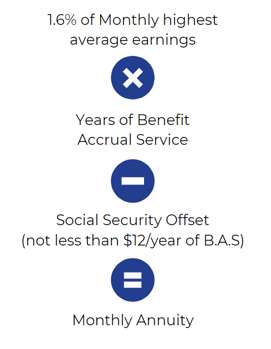
The applicable interest rate is a separate average of each of the three segment rates for the fifth, fourth and third months preceding your annuity start date. The three segment rates are calculated by the IRS according to regulations that are also part of the Pension Protection Act of 2006 and reflect the yields of short-, mid-, and long-term corporate bonds. (Note: Chevron also has Legacy Unocal and Legacy Texaco Retirement Plans)
AT&T non-management employees have their own Hourly/non-management pension plan. Let's take a look at a pension example for a gentleman by the name of Joe Smith who is hourly and using the Hourly/non-management pension plan.
In 1990, Joe is hired by AT&T and participates in the Hourly Pension Plan:
-
Hourly has a defined benefit plan that uses pension bands.
-
A pension band determines your benefits based on your job title/grade level/occupation.
-
Joe will receive a monthly dollar amount into his account for each year of service.
-
Joe's benefit (pension band may change yearly).
-
-
Hourly Pension Example
Let's assume Joe is working as a Cable Splicing Technician and is in Pension Band 120. Joe is retiring in 2021 and wants to calculate his Hourly Pension benefit.
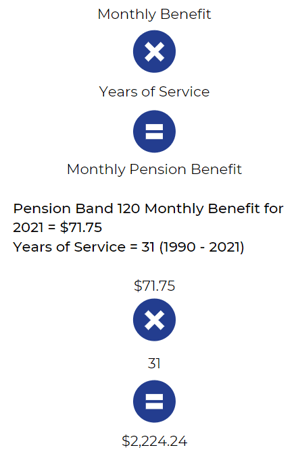
While this formula calculates a monthly pension benefit, you can determine the lump sum equivalent by using the annuity to lump sum conversion table on Fidelity's website.
If a Pension is offered, your company's retirement plan will generally allow for different forms of payment:

Single Life Annuity
- The monthly Single Life Annuity is the benefit from which all of the optional forms of payment under the plan are derived.
- Pays a fixed amount each month for retiree’s lifetime.
- A death benefit may be payable to your beneficiary.
- A death benefit is payable if vested and the employee dies before employment with their company.
Lump-Sum Option (Most Oil Companies Offer a Lump Sum)
- Lump-sum payment is actuarially equivalent to the total annuity you would have received as a Single Life Annuity during your lifetime.
- Calculated using actuarial factors based on your age and the interest rate in effect on your annuity starting date.
- No death benefits are payable.
NOTE: Lump-Sum vs. Annuity - With decreasing interest rates, your lump-sum payout will increase.
Life & Term-Certain Annuity Option
- Smaller than the Single Life Annuity.
- 5, 10, or 15 year period certain.
- If you have multiple beneficiaries or if your beneficiary is your estate or trust, remaining payments converted actuarially to a lump-sum.
- No death benefits are payable.
Looking for a second opinion about your retirement from your company? Click here to speak to financial advisor today or call (800) 200-9838.
Joint & Survivor Annuity
Upon your death, a percentage of your monthly benefit is paid to your joint annuitant for his or her lifetime
Reduction factors may apply depending on your company's policy.
Uniform Income
Receive same level of income before and after receiving Social Security benefits
The level of income may change at a certain age. For example, in the Chevron Uniform Income policy:
- Before age 62, employees receive a larger monthly annuity from the plan
- After age 62, when Social Security benefit is available, employees receive a smaller monthly annuity from the plan.
- Each company has varying rules in regards to Uniform Income. Review your company's SPD or talk to an advisor to find out the rules for your specific plan.
*These are examples and your company's plan may be different.
If you are thinking about what to do with your company-sponsored pension plan, you can discuss with a TRG advisor if you should take the Lump Sum or Annuity. When should you take it? What is best for you and your family?
You should routinely use the tools and resources found on The Retirement Group's E-Book library, such as the Retirekit, to model your pension benefit in retirement and the pension payment options that will be available to you after leaving your company.
You can also contact an energy focused advisor at The Retirement Group at (800)-900-5867. We will get you in front of an advisor dedicated to oil companies to help you start the retirement process and tell you about your payment.
Note: We recommend you read your company's Summary Plan Description. The Retirement Group is not affiliated with your company, or any affiliate.
Next Step:
- Determine if you should take your pension from your company as a lump sum or annuity.
- How do interest rates affect your decision?
- Use the "Retirekit" to understand cash flow, interest rates, and explore which pension option might be the best fit for you during retirement.
- As you get closer to your retirement date, contact a retirement-focused advisor at The Retirement Group and also read your company's SPD Summary to start your retirement process.
- Your company will need you to provide documents that show proof of birth, marriage, divorce, Social Security number, etc., for you and your spouse/legally recognized partner.
- Your company may have a Beneficiary Designation online to make updates to your beneficiary designations, if applicable to your pension program. Please read your company's SPD for more detail.
Lump-Sum vs. Annuity
Retirees who are eligible for a pension are often offered the choice of whether to actually take the pension payments for life, or receive a lump-sum dollar amount for the “equivalent” value of the pension – with the idea that you could then take the money (rolling it over to an IRA), invest it, and generate your own cash flows by taking systematic withdrawals throughout retirement from your company.
The upside of keeping the pension itself is that the payments are guaranteed to continue for life (at least to the extent that the pension plan itself remains in place and solvent and doesn’t default). Thus, whether you live 10, 20, or 30 (or more!) years after leaving your company, you don’t have to worry about the risk of outliving the money.

In contrast, selecting the lump-sum gives you the potential to invest, earn more growth, and potentially generate even greater retirement cash flow. Additionally, if something happens to you, any unused account balance will be available to a surviving spouse or heirs. However, if you fail to invest the funds for sufficient growth, there’s a danger that the money could run out altogether and you may regret not having held onto the pension’s “income for life” guarantee.
Ultimately, the “risk” assessment that should be done to determine whether or not you should take the lump sum or the guaranteed lifetime payments that your company pension offers depends on what kind of return must be generated on that lump-sum to replicate the payments of the annuity. After all, if it would only take a return of 1% to 2% on that lump-sum to create the same pension cash flows for a lifetime, there is little risk that you will outlive the lump-sum after leaving your company, even if you withdraw from it for life(10). However, if the pension payments can only be replaced with a higher and much riskier rate of return, there is, in turn, a greater risk those returns won’t manifest and you could run out of money.
Interest Rates and Life Expectancy
In many defined benefit plans, like the ExxonMobil pension plan, current and future retirees are offered a lump-sum payout or a monthly pension benefit. Sometimes these plans have billions of dollars worth of unfunded pension liabilities, and in order to get the liability off the books, your company may offer a lump-sum.
Depending on life expectancy, the initial lump-sum is typically less money than regular pension payments over a normal retirement time frame. However, most individuals that opt for the lump-sum plan to invest the majority of the proceeds, as most of the funds aren't needed immediately after retirement from your company.

Something else to keep in mind is that current interest rates, as well as your life expectancy at retirement, have an impact on lump-sum payout options of your company's defined benefit pension plans. Lump-sum payouts are typically higher in a low interest rate environment, but be careful because lump-sums decrease in a rising interest rate environment.
Additionally, projected pension lump-sum benefits for active corporate employees will often decrease as an employee ages and their life expectancy decreases. This can potentially be a detriment of continuing to work, so it is important that you run your pension numbers often and thoroughly understand the impact that timing has on your benefit. Other factors such as income needs, need for survivor benefits, and tax liabilities often dictate the decision to take the lump-sum over the annuity option on the pension.
Your Company's 401(k) Plan

When is the last time you reviewed your company's 401(k) plan account or made any changes to it?
If it’s been a while, you’re not alone. 73% of plan participants spend less than five hours researching their 401(k) investment choices each year, and when it comes to making account changes, the story is even worse.
When you retire from your company, if you have balances in your 401(k) plan, you will receive a Participant Distribution Notice in the mail. This notice will show the current value that you are eligible to receive from each plan and explain your distribution options. It will also tell you what you need to do to receive your final distribution. Please call The Retirement Group at (800)-900-5867 for more information and we can help you get in front of a specific retirement-focused advisor.
Next Step:
- Watch for your Participant Distribution Notice and Special Tax Notice Regarding Plan Payments. These notices will help explain your options and what the federal tax implications may be for your vested account balance.
- "What has Worked in Investing" & "8 Tenets when picking a Mutual Fund".
- To learn about your distribution options, call The Retirement Group at (800)-900-5867. Click our e-book for more information on "Rollover Strategies for 401(k)s". Use the Online Beneficiary Designation to make updates to your beneficiary designations, if needed.
Note: If you voluntarily terminate your employment from your company, you may not be eligible to receive the annual contribution.
Over half of plan participants admit they don’t have the time, interest or knowledge needed to manage their 401(k) portfolio. But the benefits of getting help goes beyond convenience. Studies like this one, from Charles Schwab, show those plan participants who get help with their investments tend to have portfolios that perform better: The annual performance gap between those who get help and those who do not is 3.32% net of fees. This means a 45-year-old participant could see a 79% boost in wealth by age 65 simply by contacting an advisor. That’s a pretty big difference.
Getting help can be the key to better results across the 401(k) board.
A Charles Schwab study found several positive outcomes common to those using independent professional advice. They include:
- Improved savings rates – 70% of participants who used 401(k) advice increased their contributions.
- Increased diversification – Participants who managed their own portfolios invested in an average of just under four asset classes, while participants in advice-based portfolios invested in a minimum of eight asset classes.
- Increased likelihood of staying the course – Getting advice increased the chances of participants staying true to their investment objectives, making them less reactive during volatile market conditions and more likely to remain in their original 401(k) investments during a downturn. Don’t try to do it alone.
Get help with your company's 401(k) plan investments. Your nest egg will thank you.
It’s important to know that certain withdrawals are subject to regular federal income tax and, if you’re under age 59½, you may also be subject to an additional 10% penalty tax. You can determine if you’re eligible for a withdrawal, and request one, online or by calling your company's Benefits Center.
Rolling Over Your 401(k)
Because a withdrawal permanently reduces your retirement savings and is subject to tax, you should always consider taking a loan from the plan instead of a withdrawal to meet your financial needs. Unlike withdrawals, loans must be repaid, and are not taxable (unless you fail to repay them). In some cases, as with hardship withdrawals, you are not allowed to make a withdrawal unless you have also taken out the maximum loan available within the company plan.
You should also know that your company's plan administrator reserves the right to modify the rules regarding withdrawals at any time, and may further restrict or limit the availability of withdrawals for administrative or other reasons. All plan participants will be advised of any such restrictions, and they apply equally to all corporate employees.
Borrowing from your 401(k)
Should you? Maybe you lose your job with your company, have a serious health emergency, or face some other reason that you need a lot of cash. Banks make you jump through too many hoops for a personal loan, credit cards charge too much interest, and … suddenly, you start looking at your 401(k) account and doing some quick calculations about pushing your retirement from your company off a few years to make up for taking some money out.
We understand how you feel: It’s your money, and you need it now. But, take a second to see how this could adversely affect your retirement plans after leaving your company.
Consider these facts when deciding if you should borrow from your 401(k). You could:
- Lose growth potential on the money you borrowed.
- Deal with repayment and tax issues if you leave your company.
- Repayment and tax issues, if you leave your compaany.
Net Unrealized Appreciation (NUA)
When you qualify for a distribution you have three options:
- Roll-over your qualified plan to an IRA and continue deferring taxes.
- Take a distribution and pay ordinary income tax on the full amount.
- Take advantage of NUA and reap the benefits of a more favorable tax structure on gains.
How does Net Unrealized Appreciation work?
First an employee must be eligible for a distribution from their qualified company-sponsored plan. Generally at retirement or age 59 1⁄2, the employee takes a 'lump-sum' distribution from the plan, distributing all assets from the plan during a 1 year period. The portion of the plan that is made up of mutual funds and other investments can be rolled into an IRA for further tax deferral. The highly appreciated company stock is then transferred to a non-retirement account.
The tax benefit comes when you transfer the company stock from a tax-deferred account to a taxable account. At this time you apply NUA and you incur an ordinary income tax liability on only the cost basis of your stock. The appreciated value of the stock above its basis is not taxed at the higher ordinary income tax but at the lower long-term capital gains rate, currently 15%. This could mean a potential savings of over 30%.
As a corporate employee, you may be interested in understanding NUA from a financial advisor.
IRA Withdrawal
When you qualify for a distribution you have three options: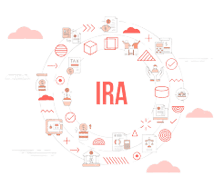
Your retirement assets may consist of several retirement accounts: IRAs, 401(k)s, taxable accounts, and others.
So, what is the most efficient way to take your retirement income after leaving your company?
You may want to consider meeting your income needs in retirement by first drawing down taxable accounts rather than tax-deferred accounts.
This may help your retirement assets with your company last longer as they continue to potentially grow tax deferred.
You will also need to plan to take the required minimum distributions (RMDs) from any company-sponsored retirement plans and traditional or rollover IRA accounts.
That is due to IRS requirements for 2023 to begin taking distributions from these types of accounts when you reach age 73. Beginning in 2023, the excise tax for every dollar of your RMD under-distributed is reduced from 50% to 25%.
There is new legislation that allows account owners to delay taking their first RMD until April 1 following the later of the calendar year they reach age 73 or, in a workplace retirement plan, retire.
Two flexible distribution options for your IRA
When you need to draw on your IRA for income or take your RMDs, you have a few choices. Regardless of what you choose, IRA distributions are subject to income taxes and may be subject to penalties and other conditions if you’re under 59½.
Partial withdrawals: Withdraw any amount from your IRA at any time. If you’re 73 or over, you’ll have to take at least enough from one or more IRAs to meet your annual RMD.
Systematic withdrawal plans: Structure regular, automatic withdrawals from your IRA by choosing the amount and frequency to meet your income needs after retiring from your company. If you’re under 59½, you may be subject to a 10% early withdrawal penalty (unless your withdrawal plan meets Code Section 72(t) rules).
Your tax advisor can help you understand distribution options, determine RMD requirements, calculate RMDs, and set up a systematic withdrawal plan.
Your Benefits from Your Company

HSA's
Health Savings Accounts (HSAs) are often celebrated for their utility in managing healthcare expenses, particularly for those with high-deductible health plans. However, their benefits extend beyond medical cost management, positioning HSAs as a potentially superior retirement savings vehicle compared to traditional retirement plans like 401(k)s, especially after employer matching contributions are maxed out.
Understanding HSAs
HSAs are tax-advantaged accounts designed for individuals with high-deductible health insurance plans. For 2024, the IRS defines high-deductible plans as those with a minimum deductible of $1,600 for individuals and $3,200 for families. HSAs allow pre-tax contributions, tax-free growth of investments, and tax-free withdrawals for qualified medical expenses—making them a triple-tax-advantaged account.
The annual contribution limits for HSAs in 2024 are $4,150 for individuals and $8,300 for families, with an additional $1,000 allowed for those aged 55 and older. Unlike Flexible Spending Accounts (FSAs), HSA funds do not expire at the end of the year; they accumulate and can be carried over indefinitely.
Comparing HSAs to 401(k)s Post-Matching
Once an employer's maximum match in a 401(k) is reached, further contributions yield diminished immediate financial benefits. This is where HSAs can become a strategic complement. While 401(k)s offer tax-deferred growth and tax-deductible contributions, their withdrawals are taxable. HSAs, in contrast, provide tax-free withdrawals for medical expenses, which are a significant portion of retirement costs.
HSA as a Retirement Tool
Post age 65, the HSA flexes its muscles as a robust retirement tool. Funds can be withdrawn for any purpose, subject only to regular income tax if used for non-medical expenses. This flexibility is akin to that of traditional retirement accounts, but with the added advantage of tax-free withdrawals for medical costs—a significant benefit given the rising healthcare expenses in retirement.
Furthermore, HSAs do not have Required Minimum Distributions (RMDs), unlike 401(k)s and Traditional IRAs, offering more control over tax planning in retirement. This makes HSAs particularly advantageous for those who might not need to tap into their savings immediately at retirement or who want to minimize their taxable income.
Investment Strategy for HSAs
Initially, it's prudent to invest conservatively within an HSA, focusing on ensuring that there are sufficient liquid funds to cover near-term deductible and other out-of-pocket medical expenses. However, once a financial cushion is established, treating the HSA like a retirement account by investing in a diversified mix of stocks and bonds can significantly enhance the account's growth potential over the long term.
Utilizing HSAs in Retirement
In retirement, HSAs can cover a range of expenses:
- Healthcare Costs-Pre Medicare: HSA's Can pay for healthcare costs to bridge you to medicare
- Healthcare Costs-Post Medicare: HSAs can pay for Medicare premiums and out-of-pocket medical costs, including dental and vision, which are often not covered by Medicare.
- Long-term Care: Funds can be used for qualified long-term care services and insurance premiums.
- Non-medical Expenses: After age 65, HSA funds can be used for non-medical expenses without incurring penalties, although these withdrawals are subject to income tax.
Conclusion
In summary, HSAs offer unique advantages that can make them a superior option for retirement savings, particularly after the benefits of 401(k) matching are maximized. Their flexibility in fund usage, coupled with tax advantages, makes HSAs an essential component of a comprehensive retirement strategy. By strategically managing contributions and withdrawals, individuals can maximize their financial health in retirement, keeping both their medical and financial well-being secure.
Company Benefits Annual Enrollment
Annual enrollment for your company's benefits usually occurs each fall.
Before it begins, you will be mailed enrollment materials and an upfront confirmation statement reflecting your benefit coverage to the address on file. You’ll find enrollment instructions and information about your benefit options from your company and contribution amounts. You will have the option to keep the benefit coverage shown on your upfront confirmation statement or select benefit options offered by your company that better support your needs. You may be able to choose to enroll in eBenefits and receive this information via email instead.
Next Steps:
- Watch for your annual enrollment information in the September/November time frame.
- Review your benefits information and utilize the tools and resources available on your company's Benefits Center website.
- Enroll in eBenefits.
Things to keep in mind :
- 47% of Americans cite healthcare as their greatest economic concern.
- Medical bills are the No. 1 cause of bankruptcy in the United States.
- For older Americans, healthcare costs represent the second-largest expense, behind housing.
Short-Term & Long-Term Disability
Short-Term: Depending on your plan, you may have access to short-term disability (STD) benefits through your company.
Long-Term: Your plan's long-term disability (LTD) benefits are designed to provide you with income if you are absent from your company for six consecutive months or longer due to an eligible illness or injury.
Your life insurance coverage and any optional coverage you purchase for your spouse/domestic partner and/or children ends on the date your employment with your company ends, unless your employment ends due to disability. If you die within 31 days of your termination date from your company, benefits are paid to your beneficiary for your basic life insurance, as well as any additional life insurance coverage you elected.
Note:
-
You may have the option to convert your life insurance to an individual policy or elect portability on any optional coverage.
-
If you stop paying supplementary contributions, your coverage will end.
-
If you are at least 65 and you pay for supplemental life insurance, you should receive information in the mail from the insurance company that explains your options.
-
Make sure to update your beneficiaries. Seeyour company's SPD for more details.
As part of your company's retirement planning and estate planning, it’s important to name someone to receive the proceeds of your benefit programs in the event of your death. That’s how your company will know whom to send your final compensation and benefits. This can include life insurance payouts and any pension or savings balances you may have.
Next Step:
- When you retire from your company, make sure that you update your beneficiaries. Your company should have an Online Beneficiary Designation form for life events such as death, marriage, divorce, child birth, adoptions, etc.
Social Security & Medicare

Knowing the foundation of Social Security, and using this knowledge to your advantage, can help you claim your maximum benefit.
It’s your responsibility to enroll in Medicare parts A and B when you first become eligible — and you must stay enrolled to have coverage for Medicare-eligible expenses. This applies to your Medicare eligible dependents as well.
You should know how your retiree medical plan choices or Medicare eligibility impacts your plan options. Before you retire from your company, contact the U.S. Social Security Administration directly at 800-772-1213, call your local Social Security Office or visit ssa.gov.
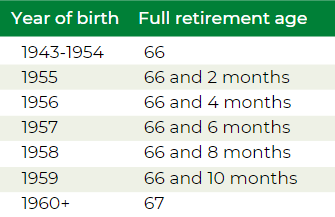
You and your Medicare-eligible dependents must enroll in Medicare Parts A and B when you first become eligible. Medical and MH/SA benefits payable under the company's-sponsored plan will be reduced by the amounts Medicare Parts A and B would have paid whether you actually enroll in them or not.

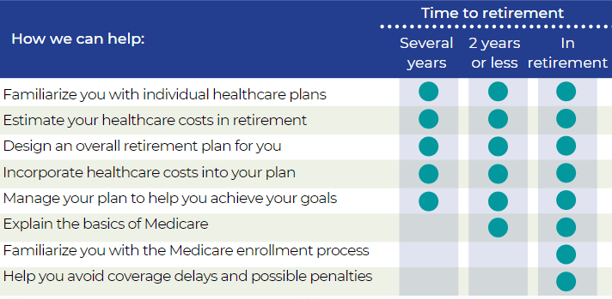
Divorce

If you’re divorced or in the process of divorcing, your former spouse(s) may have an interest in a portion of your retirement benefits from your company. Before you can start your pension — and for each former spouse who may have an interest — you’ll need to provide your company with the following documentation:
- A copy of the court-filed Judgment of Dissolution or Judgment of Divorce along with any Marital Settlement Agreement (MSA)
- A copy of the court-filed Qualified Domestic Relations Order (QDRO)
You were married for at least 10 years prior to the divorce.
You are currently unmarried.
Your ex-spouse is entitled to Social Security benefits.
Your own Social Security benefit amount is less than your spousal benefit amount, which is equal to one-half of what your ex’s full benefit amount would be if claimed at Full Retirement Age (FRA).
Unlike with a married couple, your ex-spouse doesn’t have to have filed for Social Security
before you can apply for your divorced spouse’s benefit.
Divorce doesn’t disqualify you from survivor benefits. You can claim a divorced spouse’s survivor benefit if the following are true:
- Your ex-spouse is deceased.
- You are at least 60 years of age.
- You were married for at least 10 years prior to the divorce.
- You are single (or you remarried after age 60).
In the process of divorcing?
If your divorce isn’t final before your retirement date from your company, you’re still considered married. You have two options:
- Retire from your company before your divorce is final and elect a joint pension of at least 50% with your spouse — or get your spouse’s signed, notarized consent to a different election or lump sum.
- Delay your retirement from your company until after your divorce is final and you can provide the required divorce documentation.*
Source: The Retirement Group, “Retirement Plans - Benefits and Savings,” U.S. Department of Labor, 2019; “Generating Income That Will Last Throughout Retirement,” Fidelity, 2019
Survivor Checklist

In the unfortunate event that you aren’t able to collect your benefits from your company, your survivor will be responsible for taking action.
What your survivor needs to do:
- Report your death. Your spouse, a family member or even a friend should call your company’s benefits service center as soon as possible to report your death.
- Collect life insurance benefits. Your spouse, or other named beneficiary, will need to call your companys benefits service center to collect life insurance benefits.
If you have a joint pension:
- Start the joint pension payments. The joint pension is not automatic. Your joint pensioner will need to complete and return the paperwork from your company's pension center to start receiving joint pension payments.
- Be prepared financially to cover living expenses. Your spouse will need to be prepared with enough savings to bridge at least one month between the end of your pension payments from your company and the beginning of his or her own pension payments.
If your survivor has medical coverage through your company:
- Decide whether to keep medical coverage.
- If your survivor is enrolled as a dependent in your company-sponsored retiree medical coverage when you die, he or she needs to decide whether to keep it. Survivors have to pay the full monthly premium.
Life After Your Career

Make up for decreased value of savings or investments. Low interest rates make it great for lump sums but harder for generating portfolio income. Some people continue to work to make up for poor performance of their savings and investments.
Maybe you took an offer from your company and left earlier than you wanted with less retirement savings than you needed. Instead of drawing down savings, you may decide to work a little longer to pay for extras you’ve always denied yourself in the past.
Meet financial requirements of day-to-day living. Expenses can increase during your retirement from your company and working can be a logical and effective solution. You might choose to continue working in order to keep your insurance or other benefits — many employers offer free to low cost health insurance for part-time workers.
You might find yourself with very tempting job opportunities at a time when you thought you’d be withdrawing from the workforce.
Staying active and involved. Retaining employment after your previous job, even if it’s just part-time, can be a great way to use the skills you’ve worked so hard to build over the years and keep up with friends and colleagues.
Enjoying yourself at work. Just because the government has set a retirement age with its Social Security program doesn’t mean you have to schedule your own life that way. Many people genuinely enjoy their employment and continue working because their jobs enrich their lives.
Sources

- “National Compensation Survey: Employee Benefits in the United States, March 2019," Bureau of Labor Statistics, U.S. Department of Labor.
- “Generating Income That Will Last throughout Retirement.” Fidelity, 22 Jan. 2019, www.fidelity.com/viewpoints/retirement/income-that-can-last-lifetime.
- “Retirement Plans-Benefits & Savings.” U.S. Department of Labor, 2019, www.dol.gov/general/topic/retirement.
- AT&T Summary Plan Description, 2019
- Chevron Summary Plan Description, 2019
- Shell Summary Plan Description, 2019
- ExxonMobil Summary Plan Description, 2019
- https://seekingalpha.com/article/4268237-order-withdrawals-retirement-assets
- https://www.aon.com/empowerresults/ensuring-retirees-get-health-care-need/
- 8 Tenets when picking a Mutual Fund e-book
- Determining Cash Flow Need in Retirement e-book
- Early Retirement Offers e-book
- Lump Sum vs. Annuity e-book
- Social Security e-book
- Rising Interest Rates e-book
- Closing The Retirement Gap e-book
- Rollover Strategies for 401(k)s e-book
- How to Survive Financially After a Job Loss e-book
- Financial PTSD e-book
- RetireKit
- What has Worked in Investing e-book
- Retirement Income Planning for ages 50-65 e-book
- Strategies for Divorced Individuals e-book
- TRG Webinar forCorporate Employees
- Composite Corp Bond Rate history (10 years)http://www.irs.gov/retirement/article/0,,id=123229,00.html https://www.irs.gov/retirement-plans/composite-corporate-bond-rate-table
- IRS 72(t) code: https://www.irs.gov/retirement-plans/plan-participant-employee/retirement-topics-tax-on-early-distributions
- Missing out: How much employer 401(k) matching contributions do employees leave on the table?
- Jester Financial Technologies, Worksheet Detail - Health Care Expense Schedule
- Social Security Administration. Benefits Planner: Income Taxes and Your Social Security Benefits. Social Security Administration. Retrieved October11, 2016 from https://www.ssa.gov/planners/taxes.html
- http://hr.chevron.com/northamerica/us/payprograms/executiveplans/dcp/
- https://www.lawinsider.com/contracts/1tRmgtb07oJJieGzlZ0tjL/chevron-corp/incentive-plan/2018-02-02
-
https://www.irs.gov/newsroom/irs-provides-tax-inflation-adjustments-for-tax-year-2022
-
https://news.yahoo.com/taxes-2022-important-changes-to-know-164333287.html
-
https://www.nerdwallet.com/article/taxes/federal-income-tax-brackets
-
https://www.the-sun.com/money/4490094/key-tax-changes-for-2022/
-
https://www.bankrate.com/taxes/child-tax-credit-2022-what-to-know/




